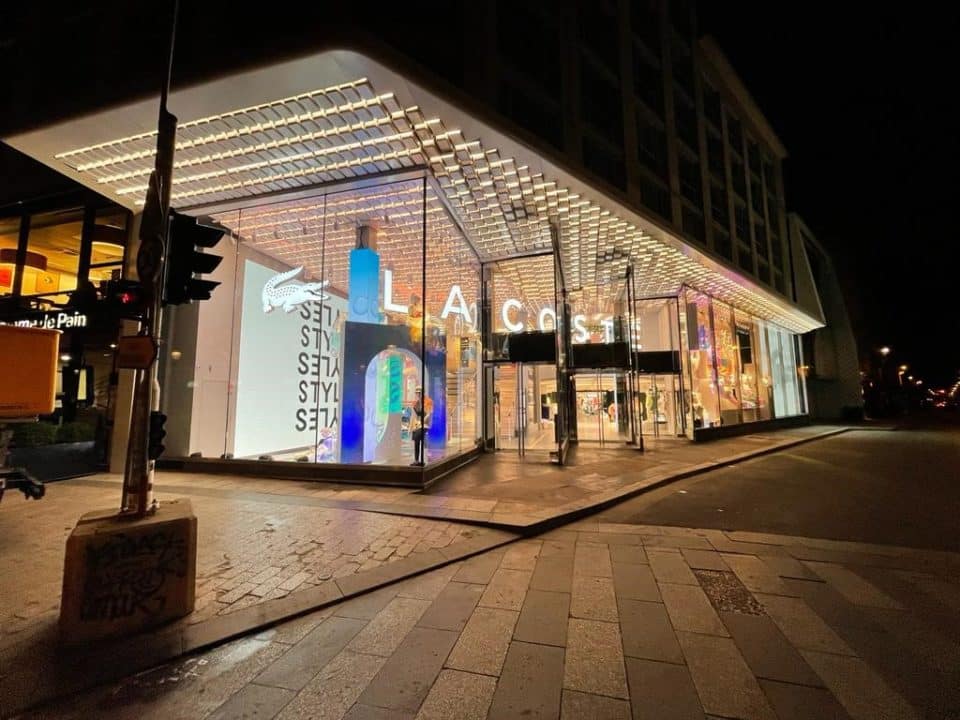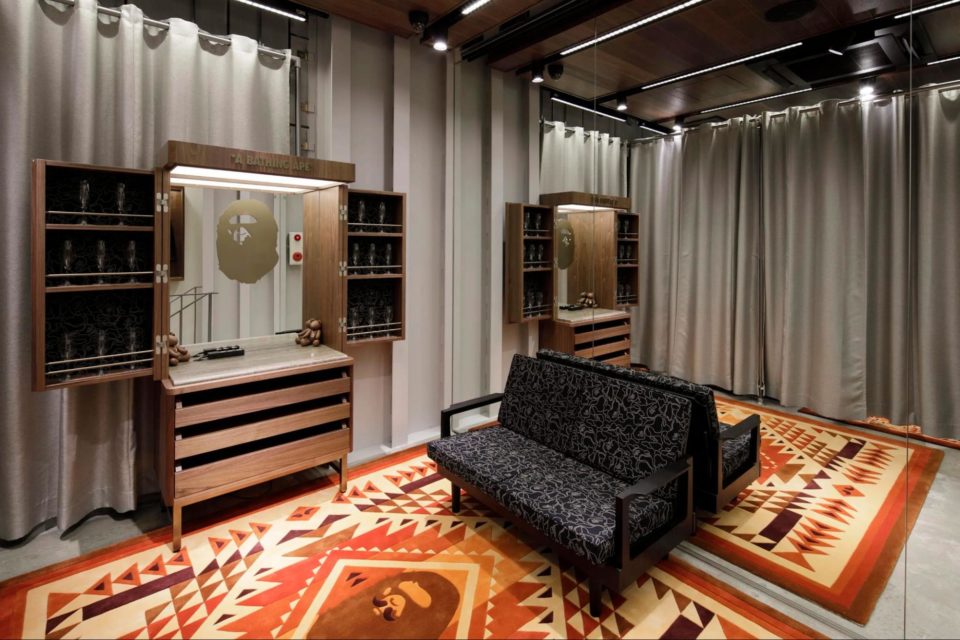Inside Walmart – how the world’s biggest retailer is innovating
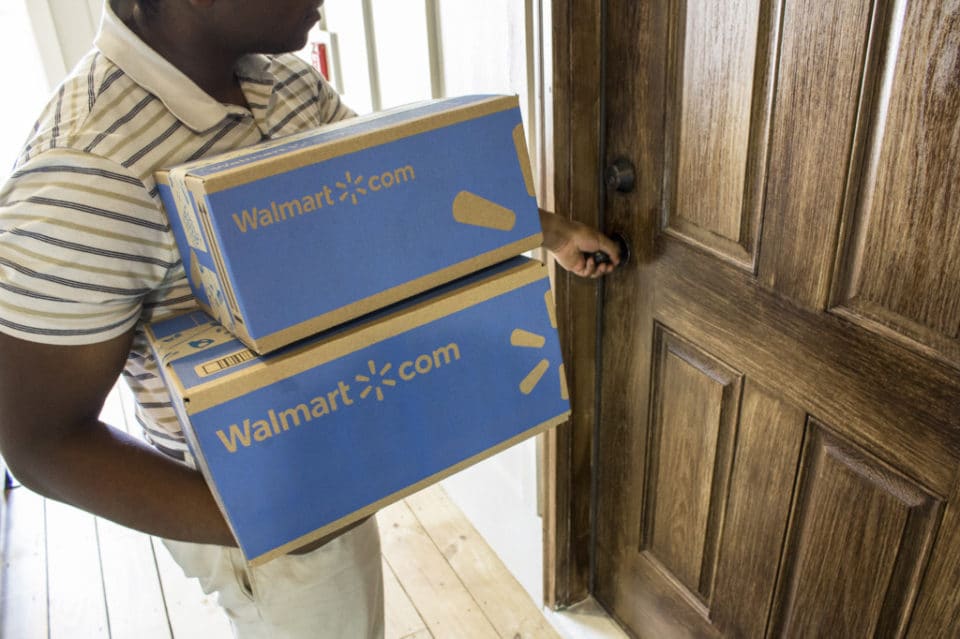
It’s been a good year for Walmart. The world’s biggest retailer recently reported its strongest quarterly growth in 10 years with same-store sales in the US up by 4.5%. Online sales also grew by 40% for the same period.
Things look good then. So, what is it about Walmart’s strategy that is paying off? This year alone the company has announced a tonne of new ideas and pilots as it looks to innovation to keep it in the top retail spot.
If you thought Amazon was the one who was in to everything, well you’re not wrong, but Walmart is playing the field too. From VR to robotics to ecommerce to a possible dalliance in video streaming, Walmart clearly sees diversification as a vital part of the push back against Amazon.
Here’s the best, recent ideas that show how Walmart’s strategy is evolving:
The grocery picking robot – Alphabot
Earlier this year Walmart announced plans to test a new custom-built grocery-picking robotics system called Alphabot in its Salem, Texas superstore. Developed in partnership with Alert Innovation, the tech can automatically ‘pick’ groceries from storage for online orders and bring them to Walmart’s staff who then put each order together. Alphabot can pick frozen and chilled items and dry goods, but staff will still pick fresh items like produce.
Initially customers will have to order their groceries for pick-up, but delivery will be an option in the future. Customers will pick-up their orders from the Alphabot warehouse at the store, which will have dedicated drive-through pick-up lanes. The test should be active by the end of the year.
Why?
A lot has been made of robotics and their potential impact on retail. What is interesting about Walmart’s approach with Alphabot is that it doesn’t remove the human element completely. It focuses them on the more nuanced part of the picking and packing process and leaves the robots to do the running around.
The tech also lets Walmart explore how robotics can help it make more of its storage capabilities. The Alphabot can move in three directions to collect goods meaning the floorspace of the warehouse can be fully maximised.
Mostly though this is about seeing whether robotics can make grocery shopping more efficient. Walmart will be looking for the tech to make filling orders faster so that it can offer a competitive service to customers – whether they pick-up from the store or get them delivered.
The automated grocery kiosk
Another spin on online grocery shopping is Walmart’s automated kiosk pilot. It started off with one in Oklahoma and has just launched a latest version in Texas. The free-standing kiosks are located in the stores’ respective car parks.
Customers place an order online which is packed in-store by staff as usual. The order is then placed in the kiosk, which has fridges and freezers to make sure everything stays fresh. When they’re ready to pick-up, customers use the interfaces in the side of the kiosk to scan their order barcode. The kiosk then automatically retrieves their order, bagged and ready to go into their car.
Why?
This is about efficiency once again. Walmart is experimenting with ways to make the customer experience as good as possible. Sometimes this means not having to step foot in the store or even speak to an assistant. Customers can just drive up, get their shopping and be gone within minutes. It also means that they can collect their order outside of normal operating hours if need be.
With customers able to increasingly shop in the ways that best suit them – online, in-store, on the go – their expectations are higher than ever. They don’t want to be restricted by the delivery or collection process. They want their purchases quickly. An automated kiosk like this can help give them that.
https://www.youtube.com/watch?v=dU6JlaEei5g
The personal concierge service – Jetblack
Jetblack is a new personal shopping service that uses good old SMS texting to get customers what they need when they need it. It uses a mix of AI and professional buyers to recommend gifts and everyday items to customers and then rushes them over the same or next day.
At present the service is in limited launch, available by invitation-only to customers in Manhattan and parts of Brooklyn. It costs $50 a month to be part of but there are no extra charges for delivery.
Why?
Personalisation has become increasingly important to customers. Giving it to them is another matter. This is one way that Walmart is courting a more upmarket demographic. Jetblack isn’t the service you might expect from a company like Walmart. It’s a way of changing perceptions of a customer base that might have previously overlooked it.
This is also about convenience. Jetblack is aimed at busy mums who may not have time to sit in front of a computer for ages or head to a store, but can dash out a quick text when they need to get a birthday present or reorder nappies. It’s taken luxury’s idea of personal shopping and made it accessible.
It also shows Walmart thinking about the customer and its relationship with them more than what they buy. Although most of its recommendations come from Walmart’s own website or Jet.com, it will also find them products from their favourite local retailers and suppliers.
Walmart recognises that for some customers price isn’t everything. Some are tied to certain brands for a reason and rather than trying to erase those bonds it’s making itself a facilitator. It is presenting Walmart in a better light, which increases people’s good will towards them.
The retail incubator – Store No. 8
Last year Walmart launched retail incubator Store No. 8. Through the initiative Walmart is growing a portfolio of start-ups that will help it to take on the retail challenges of the future. The areas it is exploring include VR, AI and robotics. The companies under Store No. 8 operate outside of the main Walmart corporation but are 100% owned and backed by the company.
Why?
Although Walmart has its own in-house R&D arm, Store No. 8 is a way for it to ensure that it’s at the cutting-edge of retail innovation. By partnering with start-ups and entrepreneurs, it is able to access and scale new thinking and technologies faster. Store No. 8 demonstrates that Walmart doesn’t believe itself to be an island in retail. It recognises that to stay ahead of the game it needs to balance useful innovation with speed to market. Store No. 8 is one way to do this.
The companies under Store No. 8 are usually thinking about retail in three to five years rather than in the shorter-term. They have freedom to think about what retail needs to be and to be out there in their ideas.
It shows that Walmart understands the need to respond to changes in customer expectations. It is not enough to just keep providing new iterations of the same thing. Sometimes you have to wipe everything away and start again to move forward.
Reports suggest that one of the projects Store No.8 is working on an Amazon Go style store that uses tech to let customers buy and checkout without the need for human intervention. Exactly what this might look like we don’t know yet, but it’s exactly the kind of thinking that Walmart needs to keep up with changes in how we live.
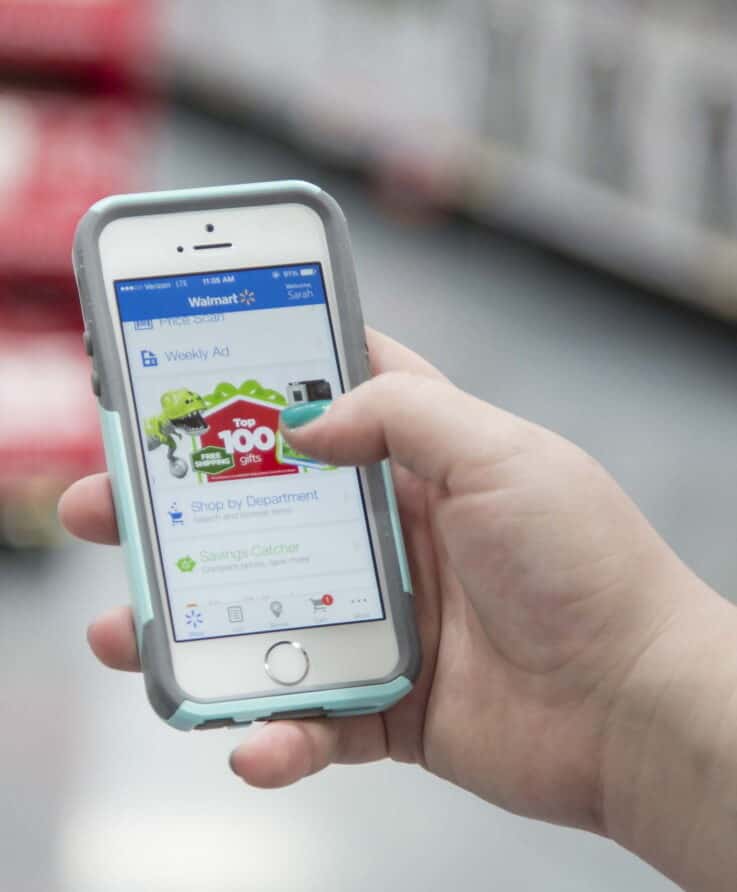
The mobile app
When it comes to mobile, Walmart is working on benefits for both customers and staff. In the case of shoppers, this year it launched a new store assistant feature to its app. Customers benefit from improved in-store navigation with the ability to search for any item and find its exact location in the store – even the aisle and shelf.
They can also search for generic and specific product terms to check the stock levels in their local store. They can add items to a shopping list, which calculates the cost of the basket as they go. This means they can see how much they’ll spend before they get to the store.
Walmart is also testing mobile check-out tech for staff. Currently being trialled in 350 Lawn & Garden Centres, assistants will be able to scan and take payments for customers’ purchases without them needing to go into the store.
Why?
Walmart has been exploring the potential for mobile for some time now. Its experiments include Scan & Go tech where customers scan products and checkout from their smartphone and Walmart Pay where customers can pay by scanning a barcode on their phone. Not all of these have worked out but have likely informed Walmart’s latest ideas.
The ability to checkout on the floor in the Lawn & Garden Centres is an inspired move. Garden supplies are often heavy, unwieldy and large. Requiring customers to bring them into the store and navigate around in order to pay is an unnecessary and frustrating step. By empowering staff to scan the items and take payment outside the main store, Walmart is removing this pain point. And if it’s successful we might see Walmart extend the ability to checkout from the shop floor further.
With the updates to its mobile app, Walmart has clearly been thinking about how its customers shop. Given the size of its stores it’s easy for customers to get lost or struggle to find what they’re looking for. By adding a detailed find function to the app it’s enabling customers to self-service when they can’t find an assistant. The focus is on improving the customer experience. It’s not selling to the customer, but making it as easy as possible for them to buy.
The virtual reality drive
Walmart is tackling virtual reality on a number of different fronts. The company has sent out Oculus Go headsets to each of its stores, nearly 17,000 headsets in total, which will be used for staff training.
It is also testing a new 3D virtual shopping feature on its website which lets customers ‘walk’ through a furnished apartment. As they explore they can click on the furnishings to find out more about the products.
There are also rumours that Walmart is working on a virtual shopping showroom. This would let home shoppers use a VR headset and gloves to shop in a virtual Walmart, pick up anything they want to buy and add it to a virtual basket.
Why?
There’s a lot of new tech floating around out there but augmented reality and virtual reality are some of the most established with customers. This is a vital piece of the puzzle as if you don’t have customer buy-in a lot of tech ideas flop. The fact that Walmart is exploring a number of ways to use VR indicates that it sees a lot of potential from the tech.
Its use in staff training is interesting. The company is rolling this out to every store after having dabbled in it previously which suggests it has seen the benefits. It gives Walmart a way to put employees into situations that they may not have encountered before – situations they can control. No-one likes having an angry customer scream at you, but you might be better equipped to deal with it when it comes up if you’ve lived it.
Staff can also get up-to-speed with new policy or in-store services faster and in a more engaging way. Think of how many times you’ve nodded off in a training seminar – now think how much more you might retain if the information was presented in another way.
While the future of shopping may not be us virtually browsing the aisles from home, Walmart is clearly thinking about every possibility. By investing and exploring at this early stage it has the chance to be a leader in how VR plays out, rather than a follower.
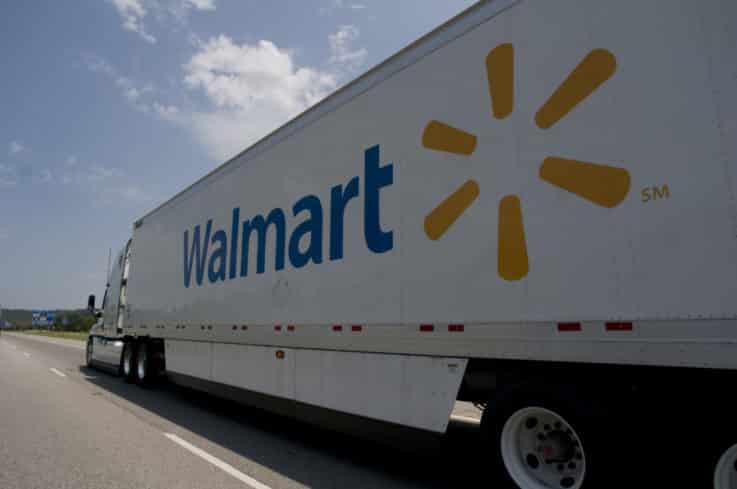
Image credit: Walmart
The delivery trials
Walmart has been doing plenty of experimentation around delivery. The company has made plans to expand its same day delivery service to more than 800 stores. Deliveries will be made in as little as three hours. Previously, to meet last mile delivery demands it has trialled partnering with companies like Uber and Lyft.
Now though it is focusing on its own crowdsourced delivery service – Spark Delivery. It uses a pool of independent drivers who sign up to make deliveries according to their schedules. Earlier this year Walmart even announced a trial partnership with Waymo that sidesteps delivery entirely by using self-driving cars to deliver customers to and from the store.
Why?
Delivery is a thorn in retail’s side. Companies like Amazon have set customer expectations higher and higher with next day, same day and one-hour delivery options. But it comes at a huge cost.
Walmart is looking for ways to overcome this. While it hasn’t all worked out, like its trials with Uber and Lyft, it is learning from each experiment. It’s these trials that likely led it to Walmart’s current Spark Delivery concept – a crowdsourced service that it has much more control over than any partner scheme.
Control is an important part of the mix as customers want to receive their groceries in the condition they expect. They want them to arrive when planned. It isn’t enough just to get them there quickly. There’s a reason why Walmart is doing so much testing around different delivery ideas. It’s trying to find the sweet spot around service, quality and price rather than committing to an untenable idea.
The Waymo service is a more out-there idea but shows how much Walmart is thinking about future mobility. It’s not just about how online order move around but people too. And what’s the stop it from looking at uses Waymo’s self-driving cars for deliveries in the future?
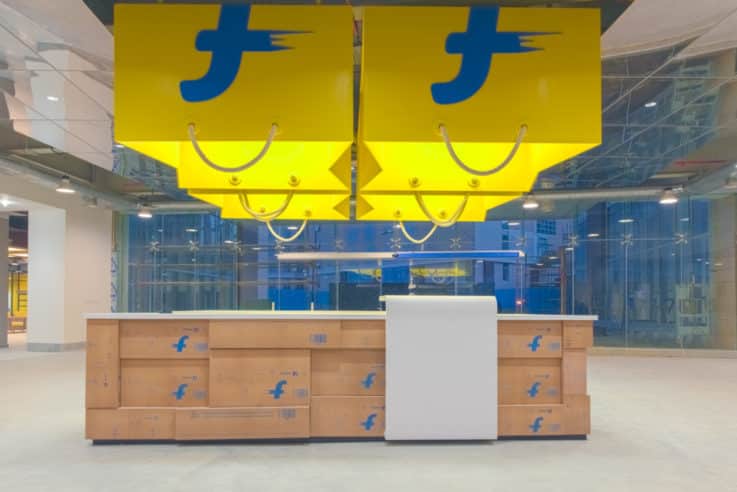
Image credit: Walmart
The ecommerce acquisitions – Jet.com and Flipkart
Jet.com is a curated ecommerce company that Walmart acquired in 2016 for $3.3 billion. It sells grocery, fashion, beauty and home items. Earlier this year Walmart became the largest shareholder of Flipkart, the Indian ecommerce company, for $16 billion.
Why?
If we had to we’d say that Walmart would prefer not to have other ecommerce rivals to have to deal with as it squares up against Amazon. It also sees acquisitions like this as a way to grow faster in new markets like India.
By buying Flipkart Walmart gained access to all its local market know-how and in-place operations, without having to do a whole bunch of groundwork. India is a hotbed for growth and Walmart is now in a great position to take advantage of that. Given the penetration that Amazon has around the world, and the fact that it was Walmart’s rival for Flipkart, the acquisition keeps Walmart in the game. Data is incredibly valuable to retailers – Walmart is amassing it through acquisitions.
Meanwhile with Jet.com, Walmart is trying out new online shopping experiences. Starting with New York, the company is trialling a more curated offering to ‘make lives better for people who live in cities.’ New York based customers now see localised product offering when they visit Jet.com. The company will also personalise its recommendations and offerings based on individual customer preferences.
It’s a smart move from Walmart given that it wants Jet.com to grow among the millennial customer base. But this will also likely serve as a test that the rest of Walmart’s business can learn from should it take off.
The brand acquisitions – Modcloth, Bonobos, Moosejaw
It’s not just the likes of Flipkart and Jet.com that Walmart has been buying up. Other brands that have become part of its family include vintage-style fashion brand ModCloth, menswear online retailer Bonobos and outdoors company Moosejaw.
Why?
Modcloth, Bonobos and Moosejaw are all well-functioning ecommerce companies in their own right. But we suspect the biggest benefit to their acquisition is information. Walmart can learn from all of them – especially when it comes to selling successfully online.
Can you think of any reason why Walmart might want to learn all it can about the ecommerce business? It’s no secret that its biggest competitor is first and foremost an online business. Walmart began life in bricks-and-mortar. It’s had to adapt to the online world rather than shaping it.
The company is also doing different things with each brand. In the case of ModCloth it has launched physical guide stores where customers can see and try on a sample of items from the ModCloth website. Anything they want to buy they order online for delivery. There also stock some one-off, locally targeted items that customers can buy and take home the same day.
It’s a spin-off of Bonobos’ Guide Shops which do the same thing – allow customers to try things on and then buy online. Both spaces benefit from in-store stylists who help customers find what they’re looking for. But again, they also let Walmart test new ways to sell to customers. It gives it room to experiment with what physical space can do on a much smaller scale than one of its big box stores.
With Moosejaw, Walmart has launched a curated microsite on its main website. The Premium Outdoor store curated by Moosejaw brings premium outdoor goods into the Walmart online world. Again, this is a test case for Walmart to see how customers respond to this type of curation. If it pays off, we may see Walmart launching similar curated microsites for its other brands like Bonobos and ModCloth.
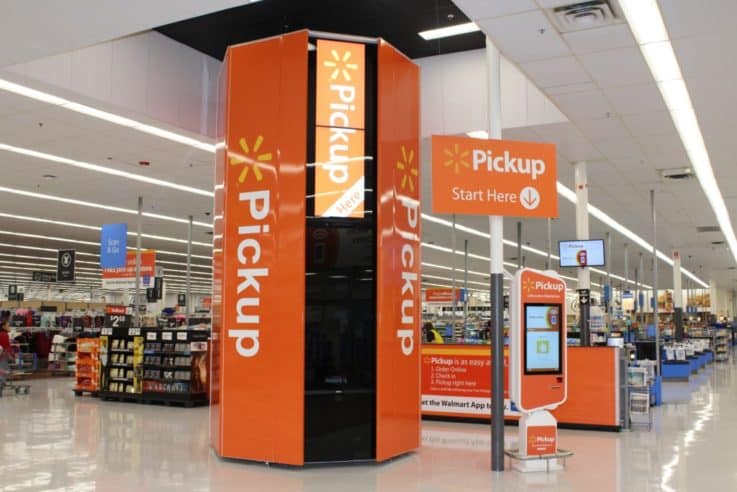
Image credit: Walmart
The in-store pick-up tower
Last year Walmart doubled down on in-store click-and-collect by putting Pickup Towers in 200 stores. The automated systems let customers retrieve their online orders without the need to stand in line or find a member of staff.
They simply scan their order confirmation barcode and the tower automatically dispenses their purchase. Walmart is now rolling out the tech in 500 more stores and adding in Pickup Lockers for larger and more bulky items like TVs.
Why?
This is one of the ways that Walmart is using its physical store network to take on online-only players. By making it possible for customers to stop by the store and retrieve their order in a matter of moments, it’s made click-and-collect extra attractive.
Online delivery can actually be quite annoying. For one you need to be in the house to get your parcel or have to deal with redeliveries or collection from a local depot. It’s no surprise that Amazon has put its lockers, which are designed to overcome this exact problem, into things like local supermarkets.
These are spaces that a lot of shoppers pass by or visit everyday while going about their normal lives. Therefore, it’s very convenient for them to be able to use something like the Pickup Tower to collect their order. The tech also frees up Walmart’s staff to deal with more complicated or valuable issues rather than hunting around for parcels. This is an important consideration.
As online ordering and click-and-collect transactions grow, this means more packages, so more storage, more handling, more staff time. Walmart is trying to head some of this off by exploring ways of automating the process.
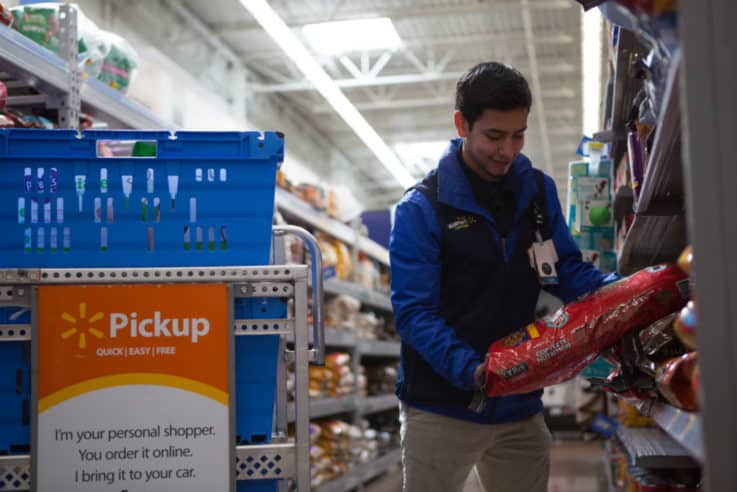
Image credit: Walmart
The other stuff – some of it
The fact is that Walmart’s been putting its fingers in so many pies recently there’s plenty more that we could talk about.
For example, earlier this year it announced that it had partnered with Microsoft to ‘further accelerate Walmart’s digital transformation in retail’. There’s a lot of speculation that this will lead to Walmart’s own Amazon Go style store of the future. Maybe it will, maybe it won’t. What it has done is made sure that Walmart doesn’t give Amazon’s cloud web services division any business. And it gives Walmart some serious tech resources to draw upon.
Then there’s Eden. This is Walmart’s tech that inspects fruit and veg for any defects and then accurately predicts the date they will spoil. It’s still early days for Eden, but it’s already reported to have saved the company $86 million in 18 months.
Right now, there’s a lot of manual intervention but the aim is that Eden will in the future use image recognition and temperature data to make its predictions. What’s also cool is the idea that Eden will monitor the temperature of produce while in transport and if it sees a spike it will reroute the truck to a closer location. The tech has the potential to massively reduce produce waste and improve quality for customers, so it’s a major one to watch.
There are also reports that Walmart might be looking to take on Amazon and Netflix with a video streaming service of its own. This isn’t brand-new territory for Walmart – it already owns Vudu which customers can use to rent or buy films.
Still, the rumoured new service would go be a serious step up. It would also be priced to undercut both Amazon and Netflix in an attempt to gain favour from middle America. It’s not clear whether Walmart really sees any profitability in such a service or if it’s just a way to try and compete against Amazon. But it certainly presents Walmart as a company thinking beyond its current remit.
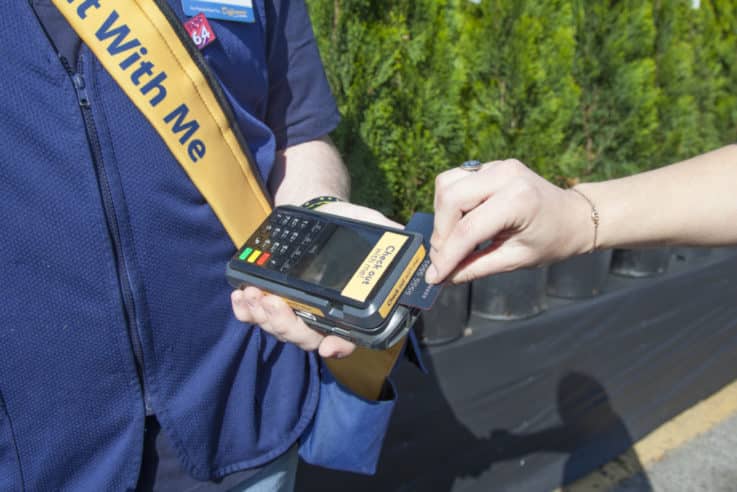
Image credit: Walmart
What have we learnt?
Walmart’s push to be competitive has given rise to an innovative mindset that encourages experimentation. The company has the resources and clout to try out new things – even going so far as to try different ways of solving the same problem. It’s this willingness to try, fail and learn that puts Walmart in a strong position for the future.
Walmart is constantly learning. It recognises that it started life in a retail world that’s very different to today, but is making sure that it isn’t left behind by acquiring companies that can boost its knowledge. By combining this with its historical wealth of data on customers and what they want, it can concentrate on improvements that benefit customers.
It also appreciates the importance of partnerships. Walmart understands that it doesn’t necessarily have all of the world’s more innovative thinkers on staff. By looking to entrepreneurs, start-ups and big names like Microsoft, it ensures that it’s always bringing in new points of view. It isn’t stuck in an echo chamber or bubble of its own making. Instead it keeps challenging its perception of what retail will be.
After all, if it wants to stay the world’s biggest retailer it has to.
How will grocery shopping change? Here’s 6 inspiring initiatives shaping the future. Want to know what the future of retail holds? Let us show you in an Insider Trends presentation.

